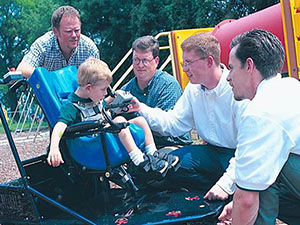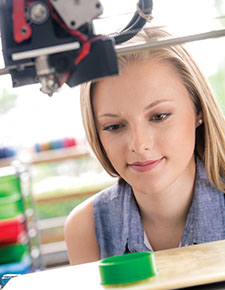For students at the University of Alabama at Birmingham School of Engineering, the Capstone Senior Design course is a rite of passage. The two-semester course requires students to work in teams, calling on all of their classroom knowledge to design a viable product and build a working prototype.
But what happens when an unprecedented disruption puts an end to in-person collaboration weeks before the projects are completed?
 This archive photo shows a typical senior design project, with students working in teams to design and build a device for a client. In 2020, teams were halfway through their second semester of work when COVID-19 made many course goals impossible.That was the challenge facing seniors in Spring 2020. Due the worldwide COVID-19 outbreak, the university transitioned to online classes after spring break. Senior design teams were unable to meet in person and building a working prototype became all but impossible.
This archive photo shows a typical senior design project, with students working in teams to design and build a device for a client. In 2020, teams were halfway through their second semester of work when COVID-19 made many course goals impossible.That was the challenge facing seniors in Spring 2020. Due the worldwide COVID-19 outbreak, the university transitioned to online classes after spring break. Senior design teams were unable to meet in person and building a working prototype became all but impossible.
“Transitioning to online learning with little time to prepare was a challenge for everyone, but for senior design, it was especially disruptive,” said Alan Eberhardt, Ph.D., director of the Capstone Senior Design Course in the Department of Biomedical Engineering. “Building, testing, and validating the functionality of students’ design projects, all of which involves hands-on teamwork, is usually 30 percent of the final grade. So, we had to completely re-think how we could fairly evaluate the students’ work.”
The result was that Eberhardt and Dale Feldman, Ph.D., who serves as a co-instructor, revised their grading rubric by removing the 30 percent prototype component and distributing those points among several other requirements, such as a final report containing an extensive Risk/Benefit analysis and a scientific poster.
“One of the strengths of this course is that students are building working prototypes for clients to address real-world challenges,” Eberhardt said. “So that became one of the challenges. How do we address an impossible situation without letting students off the hook?”
In the end, Eberhardt said, some projects were better suited for these alternate circumstances than others. For example, one team had planned to create an “empathy app.” The final prototype was a web-based application designed to help people comprehend the challenges of living with hearing impairment.
 Paige Severino was part of a team that seemed well-suited for remote collaboration. Click here to read more about her team's experience dealing with the challenges of 2020.“Designing a web-based application is not what most people think of as a typical biomedical engineering senior design project,” said team member Paige Severino. “Our team spent a lot of time learning about back-end development and taking programming courses through Youtube, but it paid off in the end. The non-traditional project where you don’t have a shiny, physical prototype actually turned out to be one that was well-suited for remote collaboration.”
Paige Severino was part of a team that seemed well-suited for remote collaboration. Click here to read more about her team's experience dealing with the challenges of 2020.“Designing a web-based application is not what most people think of as a typical biomedical engineering senior design project,” said team member Paige Severino. “Our team spent a lot of time learning about back-end development and taking programming courses through Youtube, but it paid off in the end. The non-traditional project where you don’t have a shiny, physical prototype actually turned out to be one that was well-suited for remote collaboration.”
Despite those advantages, the team still experienced some roadblocks when it came to delivering a final product. “We weren’t immune to the disruption of the COVID-19 pandemic,” Severino said. “The transition to online learning, the anxiety of the situation, and the disappointment in not being able to complete senior year in the traditional way resulted in some distraction.”
Unlike some other teams, Severino says her team was able to complete a prototype, but the verification and validation testing the team had planned was not completed.
One of the objectives in every project is to learn to work within realistic design constraints, including budget, materials, time constraints, etc.” said Eberhardt, “So in that sense, it was interesting to see how teams attempted to adapt to the challenge. But that’s not to say this was a net positive. This semester was a challenge for everyone, and I’m proud of how this senior class responded. I hope it was a valuable experience.”